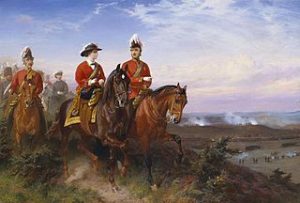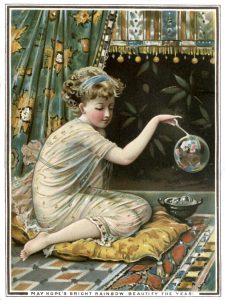Sometimes it seems that without Queen Victoria and Prince Albert western culture might not have any traditions to see out the old year and bring in the new. I exaggerate, of course, but not by much. Albert brought Christmas trees to England, kicking off our annual December traditions. But Victoria found Scottish customs at the New Year more to her taste.
Scots religious leaders banned Christmas celebrations in the 17th century. Christmas didn’t become a public holiday again until 1958, and still isn’t the primary celebration. Instead, Scots celebrate Hogmanay on the first day of the year.
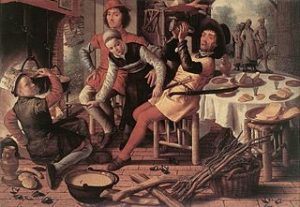 To start the new year with a clean slate Scots, threw out the ashes on their hearths the night before. This makes sense to me, except for one thing. The fire was going, and the ashes no doubt were hot. Then again, judging by this picture, perhaps it wasn’t as dangerous as it sounds. Still, I’m guessing special tools were used.
To start the new year with a clean slate Scots, threw out the ashes on their hearths the night before. This makes sense to me, except for one thing. The fire was going, and the ashes no doubt were hot. Then again, judging by this picture, perhaps it wasn’t as dangerous as it sounds. Still, I’m guessing special tools were used.
The custom of First Foot referred to the first person to cross the threshold after the stroke of midnight bearing gifts of Black Bun (a sort of fruit cake), shortbread, coal, salt, and whiskey. If the first person was male and dark haired, it would be a lucky year. If he happened to be blonde, bad luck followed. I’m thinking candidates for First Foot were vetted before the event.
When the First Footer arrived, there was probably a party going on, because custom said whatever you did at midnight as the year changed, you would continue to do throughout the year. Consequently, people socialized.
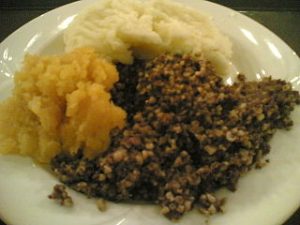 The party menu consisted of various Scottish foods, including haggis, a dish composed of a sheep’s intestine cooked inside a sheep’s stomach. That would certainly point me in the direction of the whiskey. Other foods might include neeps and tatties, meat pies, porridge, and all manner of soups. Here we see a plate of haggis, neeps and tatties (turnips and potatoes).
The party menu consisted of various Scottish foods, including haggis, a dish composed of a sheep’s intestine cooked inside a sheep’s stomach. That would certainly point me in the direction of the whiskey. Other foods might include neeps and tatties, meat pies, porridge, and all manner of soups. Here we see a plate of haggis, neeps and tatties (turnips and potatoes).
At new year, everyone should have a new suit of clothes to symbolize a new beginning, and the pockets of those new clothes should have money in them in order to ward off misfortune.
And, most important, no work of any kind (especially laundry) should be done on New Year’s Day.
From these customs, Victorians developed their own take on New Year’s celebrations.
At midnight as the year turned, Victorians rang bells to symbolize the victory of good over evil. And, householders flung open their doors to shout “Welcome” to the new year. Then the head of the household threw a cake against the door to insure there would be enough food in the coming year.
Social activities took place on New Year’s Day. In wealthy households with unmarried daughters, local bachelors were invited to call between noon and six p.m. The young gentlemen remained about fifteen minutes, chatting with the girls and indulging in various beverages. Newspapers announced which homes would be open, and callers simply presented their calling cards at the door to gain admittance.
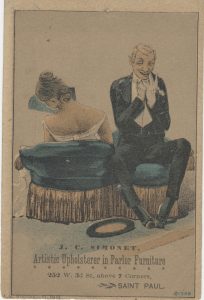 The calls became competitive. Both for how many were made, and how much punch might be consumed. Bachelors managed to make fifty or more calls during the allotted time. By 1890 the rules changed. Admittance was only be invitation.
The calls became competitive. Both for how many were made, and how much punch might be consumed. Bachelors managed to make fifty or more calls during the allotted time. By 1890 the rules changed. Admittance was only be invitation.
Meanwhile, the middling classes held “Phantom Balls” featuring costumes, card games, and sometimes an informal game of football.
Another popular pastime was telling fortunes. This was done by way of tea leaves for those who didn’t drink punch (which I’m sure the young ladies weren’t allowed), and also by what was called bibliomancy. A book, usually the bible, was randomly opened, and the first passage the viewer saw indicated the future.
Many people prefer to plan their own futures, leading to the custom of New Year’s Resolutions. More on that next week.
???
Illustrations from Wikimedia Commons.
Queen Victoria and the Prince Consort at Aldershot 1859. Public Domain.
Peasants by the Hearth by Pieter Aertsen 16th Century. Public Domain.
Haggis Neeps and Tatties by Stuart Mudie. Creative Commons Attribution.
Victorian New Year Card. c1877 “May Hope’s Bright Rainbow Beautify the New Year.” Public Domain
Victorian Parlor 1900. Public Domain.
“Top Ten Victorian New Year Traditions & Superstitions.” Victorian Trading Co. Jan. 4, 2016
Gina. “A Victorian New Year.” Victorian Wanna Be. Dec. 29, 2012
Donna Klein. “New Year Celebrations of the Victorian Era.” Recollections
Elaine Lemm. “All About Hogmanay Food and Drink.” The Spruce. April 4, 2017.

Sandra Wagner-Wright holds the doctoral degree in history and taught women’s and global history at the University of Hawai`i. Sandra travels for her research, most recently to Salem, Massachusetts, the setting of her new Salem Stories series. She also enjoys traveling for new experiences. Recent trips include Antarctica and a river cruise on the Rhine from Amsterdam to Basel.
Sandra particularly likes writing about strong women who make a difference. She lives in Hilo, Hawai`i with her family and writes a blog relating to history, travel, and the idiosyncrasies of life.

